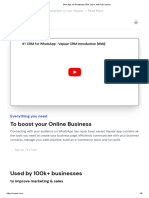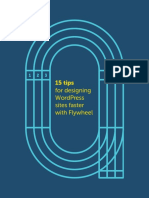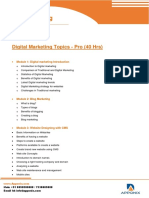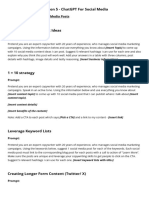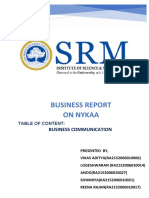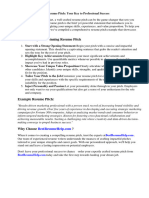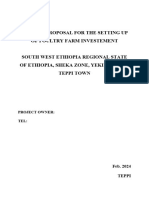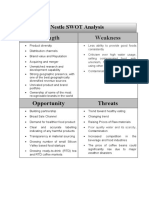10 Day
MBA
Day 1
Solopreneur
to Entrepreneur
2
� Being a Solopreneur
Freelancing is one of the most Underrated Professions in the world
Those who are not Freelancers, they consider Freelancers as Unemployed
As a Freelancer, No matter what you do, People will always Judge you, Ignore
you & Laugh at you, and once successful they’ll be Jealous of you
आज तुझ पर हं स रहे हैं जो,
वही लोग कल को ते रा गुणगान करें गे
कर के हदखा दे कोई कमाल,
तो तु झ पर सब अहिमान करें गे
हर छोटा बदलाव,
बड़ी कामयाबी का हहस्सा होता है
Beginning is often with Freelancing
Fire => Ready => Aim - That’s how 90% Freelancers get started
1. Know why you’re Freelancing
Identify your Goals
o Be Clear about what you want from Freelancing
o Use Freelancing as a Stepping Stone to Success
Identify if your Dreams and Reality Match
o Assessment of Aspirations vs Action
3
�2. Figure out your Key Strengths
How Sharp are your Skills?
o If you’re working full time, take out some Time and Money for
some Skill Upgrades. The Greater your Skills, the Higher Prices
you can set for Yourself
3. Are you New to what you do?
Time is Limited in Freelancing
o Price घटाओ => Customer बढ़ाओ
o Price बढ़ाओ => Customer घटाओ
4. Make a List and Check it Twice
Make a two-sided list. On one side are the skills you love to use and
could exercise daily. On the other side are skills you have
but don’t use / enjoy as much.
It will help you see different ways to market your- self
Sometimes the best-paying skills aren’t ones you like the most
5. Identify your Top Skills
Your Top Skills Create your Reputation—which Drive your
Marketing Message | Your Negotiating Leverage | Your Pricing
6. Can you Specialize?
Specialization Heightens Reputation.
The Best Specialties are where your Skill and Passion Intersect
7. Perform SWOT Analysis
Strength- Weaknesses (Internal)
Opportunity – Threat ( External)
8. Always Strive to Improve
The beauty is, the internet provides you with a plethora of options for
you to learn
You could join an open course, pay for a course online
More you know = More valuable you become.
Increase your prices with extra knowledge.
4
� Office Setup for Freelancers
What to Ask if you are Renting a Space
o Can I Afford it? Talk to your Accountant or Financial Adviser
o What is the Minimum Deposit?
o If I don’t want to continue the Lease, how far in advance must I
notify the Landlord?
o If you aren't tech savvy - keep a troubleshooting vendor
Priority Management
1. Set up 1-2 Priorities each day
2. Group Similar Tasks Together
3. End your day with a Self-review
4. Turn off Wifi
5. Create and Commit to your own Deadlines
6. (Current time – Ideal Time) Use a Time-tracker
Nobody is too busy,
it’s just a matter of Priorities
5
� Market Segmentation
Startup Success Happens When You See Through the Eyes of
Customer & not through the perspective of the Company
This involves:
o End user | Application | Benefits | Market Characteristics |
Partners| Size of the market |Competition
Narrow down market and satisfy every human being in the
marketplace.
Market Segmentation – Failure Points
o Selling to Everyone
o The China Syndrome
Remember - Everyone Is Not Your Customer!
Focused Pilot Market
1. Select a Focused Pilot Market
Strategy of dominating & winning smaller market first before
moving into larger markets.
Narrow down the market to maximize initial profits
Ignoring Multiple Market Segments helps
Increase Your Focus on Value Creation
2. Why Focused Pilot Market?
Allows to dominate the smaller areas
Allows to make smaller mistakes
Optimal use of limited resources.
Experience word of mouth in local market
Don’t worry about size of the Focused Pilot Market - Smaller the better
3. 7 Steps of Focused Pilot Market (Questions)
Is the Target Customer Well Funded?
Is the Target Customer Really accessible to Sales Force ?
Does The Target Customer Have a Compelling Reason To Buy ?
Can You Give Full Product With the Help of Partners?
Is there Entrance Competition (Entry Barrier)?
6
� If You Win this Segment, will You Expand
To Adjacent Market?
4. Focused Pilot Market Example : Amazon
Jeff Bezos started Amazon focused on books
After winning FPM..
Amazon began to expand into adjacent categories.
His FPM acted as foundation to build larger product categories.
Electronics, Fashion, Groceries to everything & now become multi-
billion $ Co.
5. Focused Pilot Market Example : Tinder
Tinder launched on September 12, 2012 and the marketing was
originally focused only to college students on the West Coast of the
U.S.
College Population: Tinder hired “college campus reps” to help
promote the app to their peers.
Organized College Parties | Entry with Tinder App
6. Focused Pilot Market Example : LinkedIn
LinkedIn had targeted Recruiters as its FPM.
Presence of recruiters attracted business executives who were seeking
a job..
Later Positive word of mouth helped others join the network.
7. Persona for the Focused Pilot Market
Persona is a mini-biography of a real user
Describe their goals, strengths, pains and motivations.
Build a very detailed description of real consumer.
Focused Pilot Market Helps in Understanding
o Marketing Messages
o Decider Influencer Buyer Consumer
A Startup does not begin by
Hiring People,
Building Product,
or Hiring Developers,
it begins - when you fulfill
an unmet need of the customer
7
� Decision Making Unit
Determine the Customer’s Decision Making Unit
Who Makes Buying Decision
o Secondary Influencers: They include
o Media publications | Outside Contractors |Friends & Family |
Industry Groups | Websites | Blogs
Ask Yourself:
o Who besides customer would be involved in the decision|
o Who will have the most influence
o Who could stop this from happening
Product Development
Define the Minimum Viable Business Product: Three Conditions
1. The customer gets some value out of the use of the product
2. The customer pays for the product
3. The product is sufficient to start the customer feedback loop to build
improvement cycles
Build your Brand (Creating your Portfolio)
A brand is no longer
what we tell the customer it is –
it is what customers
tell each other
8
�Build your Personal Brand
Building a Personal Brand is Important but its not Easy
Your portfolio of Skills Testimonials,
Accolades, Case Studies etc. on Web
Social Media
o Link what you do to your Website & all Social Channel
o Make an Announcement that you’re Open for Business
o Ask your Social Network to Share the News about you
o Email your Friends, Make a Personal Update about what you’re
up to and why
o Join Facebook Groups. They have Gained Popularity in the Last
Few Years Category Wise Groups.
o Introduce yourself to the group, explaining how you help
o Answer questions. Be helpful. Build relationships. Don’t Just post
links on hire me
o Let People view you as an expert in your field.
Portfolio
o Show off examples of your work in a portfolio or a blog
o Display your services with a contact form
so people can easily get in touch with you
o Portfolio makes you look more Professional Amongst
Unprofessional Freelancers – having a website will make you
stand out and shows you’re serious about business.
Portfolios are everything, promises are nothing
It’s all about Presentation
o Your Business Card has to Stand out –
Make your Own Template - Who are you | Your Unique Value |
Contact Details
o Go Digital. A virtual business card saves you from ending up in
dustbin
Excellent Presentation, Gets Sold without hesitation.
9
� Customer Acquisition
When Freelancers are asked about their Biggest Problem in Freelancing Business,
almost everyone has the same answer – FINDING CLIENTS – Have
Enough Clients - Not too few and not more than you can handle.
You don’t get paid
for the time you spend
You get paid
for the value you create
1. Introspection
How Will Customers Know About Your Brand?
How Will Customers Analyse Your Product?
How Customers Will Acquire Your Product?
How Customers Will Pay For Your Product?
2. Consumer Empathy
For example, If your specialty is “I’m the most detail-oriented
freelance animator in town,” but your customer’s need is “We need it
fast, not perfect,” you’ll quickly become the most detail- oriented
unemployed freelancer in town.
Look for what’s important to them, and in what order?
Speed? Efficiency? Accuracy? Beauty? Durability? Luxury?
Affordability? Simplicity? Health? Security? Reliability?
Profitability?
Your customer doesn’t care
how much you know
until they know
how much you care
10
�3. Networking
Join Professional Association and attend Events. - Make small talk
Keep showing up and you’ll soon feel welcomed
Build your Love Bank Account. - Change your mind-set from “What
can I get? to “What can I give?” (Give-Give-Give-Ask)
Don’t be one of those “calls-only-when-they-want-something”
Networkers
Tap your Existing Network
Someone in your circle might need your services - Classmates, Old
Colleagues, Professors and Teachers, Past Bosses
Start conversations. Don’t talk about yourself the whole time.
Never miss to exchange contact so you can connect with them after
the event.
Don’t ask for a job. Talk about how you might be able to help them.
Stay in touch without being Creepy
Add everyone you met to LinkedIn and follow up with a ‘nice to meet
you’ note within a few days of the event.
4. Choose your Prospects
Make a list of Businesses, Professions, Industries, or Companies
might need you?
Rank them, from Ideal Candidates from Top to Down.
What makes them ideal?
Their fitment against your skills? Their pay scale?
Their size (big-stable, midsize-busy, Startup-growing)? Their
reputation?
Think about where your prospects go, in person and online.
What organizations do they join? What websites, blogs, or
discussion groups do they visit? Where do they go to hire people like
you?
5. Don’t be Obsessed about How you Say it!
Sounding too Rehearsed can make people Uncomfortable
- Practice Verbal Mirroring: (Less Scripted)
6. Follow up … Follow up … Follow up
When you get home, jot down some key words on their cards about
what you talked about
Include the Notes to your Contacts List
Next Day, Call or Email to mention some specific learning or +ve
experience with them
11
� Not following up
with your prospects is
the same as filling up
your bathtub without first
putting the stopper in the drain
7. Know when to Persist or Desist
Push Relevant Anticipatory Content
If you keep trying and never hear back,
you might choose to stop. Certainly stop if someone asks you to.
8. Free CRM to Track your Conversations
Pick up the Conversation where you left off when you Called or
Emailed and what you sent
Just find a System that Works for you and Maintain it as Carefully
as you would your Financial Records
After all, this is an Investment Record—of your Time and Energy
How you gather, manage and
use information
will determine
whether you win or lose.”
Bill Gates
9. Consistency Builds Recall Value
Trust is built with Consistency - Be consistent with your work
Consistency is what transforms average into excellence
Consistency is what takes something you do one Day and turns into
a lifestyle
12
�10. Common Connection
Eg: Same School, Same Professional Group, Same Place of Worship
Same Goal, Social Service etc.
11. Authority
All the Doctors Display their Degrees in their Offices
It Promotes Trust in their Authority
Display your Résumé, Website Bio, Portfolio, Client List,
Professional Titles, Memberships, Certifications, Special Training,
and Awards
12. Build Your Trusted Inner Circle
13. Job Portals
14. Partner with other Freelancers or Entrepreneurs
15. Set up Google Alerts for Relevant News
16. Share work sample portfolio with clients regularly
17. Check your Online Reputation
18. Become an expert on up-coming tools
19. Build case studies on your expertise
20. Targeted Ads for Ideal Client
21. Get Listed in Directories
22. Offer 30-minute Phone Consultations
23. Partner with People who Complement your Skills
24. Produce your own Monthly Newsletter
25. Register for Freelance Newsletters
13
� Startup Resource Websites
Best Websites for Writers
o Medium
o Grammarly
o Wattpad
o Writer Access
o The Creative Penn
o Blogger
o People for Hour
Best Websites for Designers
o Canva
o Behance
o Adobe
o WordPress
o Dribble
o Wix
o CodePen
Best Websites for Developers
o Git Hub
o Upwork
o Site Point
o Code Wars
o Code Beautify
o Code Project
o Toptal
Most Common Consulting Websites
o Accenture
o Quora
o Presto Experts
o Launchpad
o Four Fold
o Navigate
o BKC Consulting
14
� Best Websites for Virtual Assistants
o Belay
o Time Etc
o ClickWorker
o Fancy Hands
o Assistant Match
o Zirtual
Best Websites for Marketers
o Hub Spot
o LinkedIn
o Sem Rush
Best Websites for Photographers
o Shutter Stock
o Flicker
o Pixa bay
o Image Bazar
o Getty Image
Best Websites for Customer Support
o We Work Remotely
o Virtual Vocations
o Support Driven
The Struggle you’re in today
is developing the strength
you need for tomorrow
15
� Sales Cycle of Customer Acquisition
Map the Process to Acquire a Paying Customer
o Estimate your sales cycle and identify the hurdles
No of Days Needed to Acquire a Paying Customer
o Understanding the length of the sales cycle
o It helps in measuring expense to acquire new customers.
Long Sales Cycles can be Dangerous
o Long sales cycles cost a lot of money
o Cost behind all of the sales and marketing efforts include:
Salaries of Salespeople |Printing of Brochures| Creation of
websites | Costs of trade show exhibits | Advertising in industry
publications | Development of White Papers
Pricing Strategy
1. Always Ask for Budget before giving a Price
2. Always show Bundled Price
3. Call Yourself a Consultant
4. Don't Lower your Rates in the Hope of Future Work
5. Do Free Work for Testimonials
6. Exclude Revisions from your Scope
7. Increase Rate 5-10% every 6 months
8. Learn to Say No
9. Listen More than you Talk
10. Decide Shorter days at a Higher Rate – Better CashFlow
16
�11. Schedule Work with Milestones
12. Track your Time
13. Use Value-based Pricing
14. Plan your Fee Structure Per Hour | Per Day | Per Unit (Quantity) |
Project Completion Fee | Minimum Amount | %age of Profits
15. Calculate your Fee Structure - Billable Time | Purchase Made for Project
| Overhead Expenses| Profit Margin | Market Considerations
16. Know your Lowest Price - You won’t go Below
17. Know the Benchmarks for Rates in your Industry
18. Calculate and Communicate your Numerical Worth
19. Calculate your COGS (Cost of Goods Sold)
20. Identify the Options Available for your Customer
21. Pricing Should be Based on Lifecycle of your Product
22. Drop the Price at Later Stage
23. Predatory Pricing – Barrier Pricing
It is the Practice of using Below Cost Pricing to Undercut
Competitors and Establish an Unfair Market Advantage
Seller sets a price so low that other suppliers cannot compete and are
forced to exit the market.
24. Define your End Consumer’s Profile
Opportunistic | Premium | Chinese Market Value for Money
25. Design a Pricing Strategy
Milking or Skimming - Generate Further Profit from Established
Product - It works only when few competitors are there
17
� Penetration Pricing: Break Even Price and
Aggressive Marketing - Used in Very Competitive Markets to Hit
the Established Leader
Loss Leading: Price is Less than Cost
Remove Competitors or Establish Market Share - If Demand is too
High, Losses Escalate - Difficult to Increase Prices Later
26. Design a Pricing Model => Free-mium | Premium
27. Different Type of Customers Pay Different Price
Mobile Handset: High Price Initially and Gradually reduce to Low
Price after time
Real Estate : Low Price Initially and Gradually increase to High Price
after time
The Moment you make a
Mistake in Pricing,
You're Eating your Profit
18
� Negotiation
Freelance doesn’t mean work for free
If you’re good at something, never do it for free
1. Don’t go in Blind
Learn about your Prospect
Read Financials, Press, Reviews, Complaints.
Visit their Website, Blog, and Social Media Feeds
Never Negotiate out of fear - But Never Fear To Negotiate
2. Identify your Must Haves
Know your deal breakers and deal makers before negotiating
You Do Not Get What You Want - You Get What You Negotiate!
3. Think Twice before Lowering your Price
Too much price flexibility suggests that your work has no clear value.
Don’t expect your client to respect your worth if you don’t. Also, if
word gets around about your rates, it can be tough to raise them.
4. Silence is Powerful Tool
When in doubt … Stay Silent! Its better than over committing
5. Be Cool about Talking Money
Ask Straight …Do you have a project budget?” “Do you have a range
in mind?”
If the client ask, “What’s your fee?” Turn it around to talk tasks and
value: “Let’s talk about what you want to do. Then we can talk about
what that would cost.”
Instead of a single price, quote a range or give an array of prices
Ask for details :“It’s hard to cost out a project accurately without
proper information
6. Don’t Work for Free
Know the lowest price you will do the project.
Determine Your Minimum Acceptable Rate (MAR)
Don’t do free work just to prove that you are working.
Brief sample for free or do a longer sample for a fee.
19
�7. मन की सुनो, सोच के चुनो
If you sense a Prospect will Cost More to Keep than Lose
Negotiating over Nothing | Making Constant Changes
He Who Learn to Disagree Without Being Disagreeable Has
Discovered the Most Valuable Secret of NEGOTIATION!
Quantify your Value Proposition (Creating Value)
1. Create and Show Value
Explain how you’re Adding Value to their Project
Explain why your Skills are a Great Match for their Project. Every
Skill has a Price
Value Creation is Foundation of the Pyramid
2. जो वैल्यू आप अपने कस्टमर को दे रहे हैं उस वैल्यू का गणित लगाइये
णकतने रूपए का खचाा घटाया ?
णकतने रूपए का लाभ णदलाया?
णकतने रूपए के कस्टोमेरो को जोड़े रखा ?
णकतने रूपए की Branding Improve कर के दे दी ?
णकतने रूपए का नया कस्टमर ला के णदया आपने?
णकतने रूपए की Productivity बढ़ाई?
णकतने रूपए का Employee Satisfaction बड़ा णदया?
णकतने रूपए का उसका णबज़नेस स्केल कर णदया?
णकतने रूपए का उसका माणकाट शेयर बड़ा णदया?
णकतने रूपए की Profitability बड़ा दी?
Contracts and Paperwork
1. Use a solid and well-scoped contract
2. Always get a down payment
3. Automate your invoice reminders
4. Charge fees for late payments
5. Invest in accounting software
6. Use a contract for free work too
7. Build & Accept various forms of payment
20
� Off Season (Dry Time)
1. Keep a Routine
Treat your work days like any other.
Touch base with former Clients and Potential Blue Chips | Seek
Referrals | Follow up with New Contacts |
Join Events to Network
2. Keep Networking
Because you Never Know where the Next Project Might Come From;
Revive Contacts
3. Update Online Platforms
All that you forgot to update when you were busy
4. Stay on the Top of Your Customer’s Mind
Ask for Testimonials from Satisfied Clients and Leverage them
5. Evaluate your Business Mode
Build a New Product Line Especially for Off Season
Add Complimentary Freebies, Product or Service
6. Focus on what you can’t do During the Season Time
Upgrade Skills by taking online tutorials/ course
or get coaching from expert
7. Money Saved is Money Earned
Prepare a Financial Cushion for a Predictable Slow Period (post-
holidays, post-taxes, post-wedding season, post- school year)
8. Go where the Season is
9. Extend your Season10x your Content Marketing
10. Work on Technology Automation
11. Build Scarcity with Limited Edition Products
12. Attention on Retention
21
� Cost of Customer Acquisition
COCA is also called Performance Marketing
1. Estimate the Lifetime Value of an Acquired Customer
Lifetime Value (LTV) is the average revenue one will make on a new
customer
It is also called Customer lifetime value (CLV)
The longer a customer continues to purchase from a company, the
greater their lifetime value becomes.
2. Improving Customer Lifetime Value
Customer lifetime value can be improved through - Customer
Satisfaction | Customer Retention
3. Types of Customer Revenue Streams
One Time Revenue Stream: Real Estate Company
Recurring Revenue Stream: Subscription Model
Additional Revenue Opportunities: Upsell
Repurchase Rate
4. Importance of COCA
Return on Investment
If COCA Life Time Value = Business Loss
If COCA Life Time Value = Business Profit
Clarified Expectations helps in Customer Retention
1. Discuss the Complete Scope of Work
2. Availability on Weekends and Holidays
3. Availability on Weekdays
4. Method of Monitoring Progress
5. Process of Feedback and Approvals
6. Any other Policies and Procedures
22
� There is only one boss.
The customer.
And he can fire everybody
simply by
spending his money
somewhere else
Communication – Clarified Expectations
1. If something could derail a project, record it!
2. Pre-communicate and Over-communicate
3. Ask for the Right Medium–Email/WhatsApp/Message/Call
4. If a Client is Upset, let him vent out-Emotions
5. Never go out of Communication
Post Linked in Sales
ABC stood for
Always Be Closing.
Now it means
Always Be Connecting.
23
� Be There | Prepare | Say you Care
Remember: Feedback is the Breakfast of Champions
1. Friend Raising vs Fund Raising
2. Keep up with the Latest News about your Clients
3. Propose an Agenda for Every Meeting
4. Send a Recap Email after Each Meeting
5. Under Promise and Over Deliver
6. Say what you can do, not what you can’t
7. Be on time for meetings and calls. People might not comment on it, but
being late is noticed
8. Don’t Multitask on Calls - Unless there is a deep crisis, don’t take calls
during meetings with clients
9. Stay in touch. Not just when you’re paid to be.
10. Let the client know that you are prepared:“I looked at your website . . .”
“I did some preliminary research . . .”“I was reviewing my notes . . .”
“I read your latest book . . .”
11. Transparency Builds Trust - People are most Vigilant at the Start of a
Relationship
12. Personal caring counts hugely:
24
� “Years ago, A customer left a message to cancel
the meeting because his wife had a health emergency.
I left him a message saying I hoped his wife was OK. He’s never
forgotten that I was the only one who called to express concern for his
wife.”
13. While Breaking a Bad News, – Stay Close Staying close helps you
manage perceptions - Acknowledging ≠ Admitting
14. If there is a Complaint, always begin with a Good News
15. Mutually Agree on the Process of Moving Forward
o Suggest Solutions; Talk about Positives
o Follow-up in Writing and Take a Buy-in
16. Reputation is the New Currency
17. Honor your Commitments
18. “I CAN’T” vs. “I CAN” STATEMENT
19. Don’t take Blame for what isn’t your Fault, but take Responsibility
when it is
20. Never Let the Client Dominate – Be Assertive!
21. Always Have an Exit Strategy with a Tough Client
25
� Next New Market
1. Identify Gaps in the Outer Market
2. Begin with Smaller Market of Periphery
3. Give Less Quantity and Less Credit to Distributor
4. Don’t Block your Money… Take Payment before 2nd Supply
5. Discuss and Keep a Credit Limit with your Distributor
6. Focus on the Depth not on Width (Become a Local Brand)
7. When your Market Share is 10%, then Move Further
8. Create Visibility in Local Market First
9. Keep the Delivery and Distribution Cost Reasonable
10. Commercial Terms has to be Same Across Trades
11. Estimate the Total Addressable Market (TAM) Size for Next New
Markets
12. Plan your Next New Market
13. Next Market that you Identify after Focused Pilot Market
14. 2 Questions for Follow On Market
What's the total Opportunity Size
Readiness with Team – Tech – Training For Next Target Market
26
� 15. Define your Core - After your Experience with
Focused Pilot Market
Reason for Customer to Switch
Must have at least 1 single thing that another company doesn’t have
Core provides you a certain level of protection
A Core is an advantage that continues to put one ahead of his
competitors
Startup Success depends upon the Core of the Company.
Core is also Called Secret Sauce
Most Concentrated Way to gain differentiation from your
Competitors
If Core has Clear Strength and more clarity then surely Investor will
invest in the Business.
First Mover advantage can never be the core of the Company but it
can help in capturing more market
How to Build Core? (Fundamentals of a Strong Core)
Unique: This asset is difficult for anyone else to replicate.
Important: Something your target customer values very high
Grows: It should increase in strength over time against competitors
VIS --- Valuable – Inimitable – Scalable
Examples of Core
1. Intellectual Property Protection - Microsoft
2. Patent and Licensing - Pharma Industry
3. Distribution Network – Unilever/ Pepsi
27
� 4. Exclusive Rights - Xiaomi/Flipkart
5. Proprietary Technology - Krypton(Oyo)
6. High Capital Investment - Reliance Jio
7. Economies of Scale – D Mart
8. Brand Equity - MSeal and Fevicol
9. Excellent Customer Service - Dominos
10. Loyalty Beyond Logic - Apple
11. Ongoing Innovation - Hindustan Unilever
12. National Sentiment - Patanjali
13. Subscriber Base – Aaj Tak Channel
14. Product Differentiation - Apple(Quality) | Xiaomi (Price)
15. Trade Secret - Coca Cola
16. Trust - Real Estate
17. Manufacturing Efficiency - Mc Donald’s
18. Quality and Reliability – Toyota Innova
19. Customer Cost of Convenience - iOS and Android
20. Accreditations and Certifications - FSSAI| NABH| IDA
21. Market Responsiveness - Google
22. Personality – Dr. Vivek Bindra
Core of Apple
Unique Operating System
Non Hack able | Non Replicable Hardware & Software
28
� How to Scale your Business?
1. Immediate Cash flow
Will there be income soon (5), or will it take longer (1)?
2. Regular Cash flow
Will the Income be Predictable (5) or Periodic (1)?
3. Sustainable Cash flow
Will the Income Continue (5) or last for a Limited Time (1)?
4. Increasing Cash flow
Can the Income Increase Overtime? Yes(5) or No (1)
5. Your Personal Time to Manage
Hours Per Month of your Time? None (5) or A Lot (1)
Convert Critical into Repeatable
MBA (Management By Absence)
1. INTEGRATION: One Person doing Many Things
2. DELEGATION: Delegate what you Cannot Do
3. ELIMINATION: Eliminate what is Not Needed
4. AUTOMATION: Build Technology
5. LIBERATION: Outsource
29
� More Customers = More Turnover
More Transactions = More Turnover
More Frequency (Loyalty) = More Turnover
More Price (Strategic) = More Turnover
More Products = More Turnover
Solopreneur to Entrepreneur
If you have more work than you can handle most of the time
Raise your Prices
Market yourself to Higher-tier Clients
Be Selective about what you take on
Subcontract Work
Develop Passive Income Streams
Research New Markets – Geographical Expansion
Availability of Resources
Consortium Based Projects
New Technology Transfer Agreement
Home Market Becomes Saturated
Political Factors in Destination Country or City
30
� Economic & Legal Factors in Destination
Country
Consideration of Working Capital
Localization is the Real Globalization
Inorganic Strategy - Acquisition
Distributor, Super Stockiest and C&F
Consistency is the Cost
Discipline is the Fee
31













